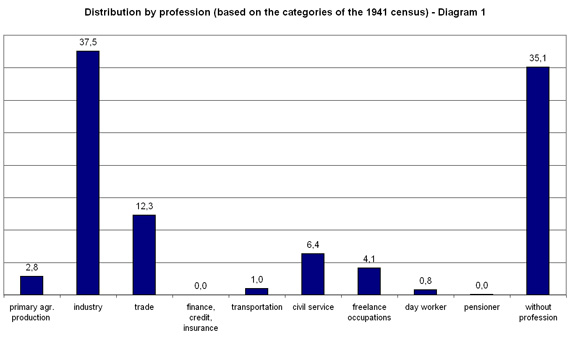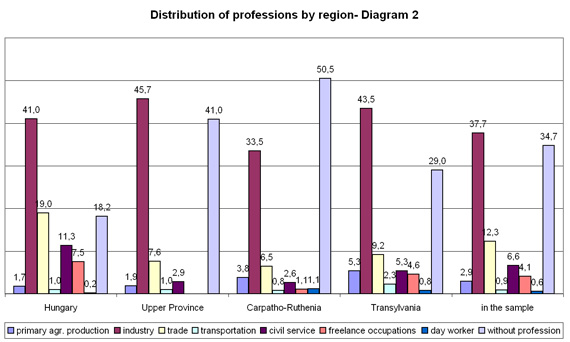The Occupational Attributes of the DEGOB Protocols' Survivors
The occupational categories of this analysis were created according to the occupational main groups of the 1941 census. We left out those main groups which no survivor belonged to.[1]

The diagram shows that the two main groups are of those working in the industry and that of those without a profession. The high proportion of those working in the industry is not surprising, since approximately one-third of the wage earners of the Hungarian Jews fell into this category;[2] nevertheless in the case of the DEGOB survivors we are referring predominantly to smaller industry. If we examine the diagram disregarding the group of those without a profession, then the proportion of those working in the industry is outstandingly high (57.8 percent).
Knowing the occupational structure of Hungarian Jewry, the proportion of the merchants is surprisingly low (12.3 percent-disregarding those without a profession, this number is still only 18.9 percent), since according to 1930 data (referring to Trianon Hungary), 42.3 percent of the wage earners worked in this sector. In 1930 three-quarters of Jewish wage earners worked in trade and industry. This majority proportion is valid referring to the DEGOB protocols too, although in a more moderate way. Nevertheless, the position of the two groups is changed, and those working in the industry take the vast majority.
In the case of those having a profession, the relatively high proportion of civil service and freelance occupations is apparent. The proportion of these two sectors is 16 percent, which is twice the number of the 1930 census.
Taking the tragedy of the Holocaust into consideration, it is not surprising that we have found only two pensioners out of the 4838 survivors; although the number of elderly persons giving testimony is somewhat higher. In the case of the other occupational groups, we find proportions that are by and large in compliance with the data of the censuses.
To sum up, we may conclude that the large majority of the DEGOB protocols' survivors were students, dependents or worked in smaller industry.
Distribution of professions by region

We have somewhat narrowed down the regions and the occupational categories. Due to a low number of cases we have left out the regions "Southern Province", "abroad" and the occupational categories "financial workers", "pensioners" and "day workers". On the other hand, we fused the regions "Budapest" with the "Hungarian countryside" into the category "Hungary".
Perhaps it is not surprising that because of the dominance of Budapest, the proportion of those without a profession is the lowest in the region "Hungary"; at the same time the proportion of those working in trade, civil service and in freelance occupations is the highest here.
It is also notable that in the re-annexed territories the proportion of those without a profession is particularly high-e.g., in Carpatho-Ruthenia they constitute the absolute majority, in the Upper Province their proportion is 41 percent, in Transylvania 29 percent.
As we have seen, one of the typical survivors according to the DEGOB protocols is a young woman from Carpatho-Ruthenia, belonging to the age group of 16-25 years, who lived in a village. In this region the majority of the Jews were very observant, thus the young women's inactivity in the labour market was quite frequent. (It is also possible that one of the reasons behind the high proportion of those without a profession is the fact the anti-Jewish laws were implemented in the re-annexed territories in a stricter way than in Trianon Hungary.)
To sum up, we might conclude that based on the DEGOB protocols, the occupational structure of the Upper Province and Transylvania is similar to each other and the whole sample, while that of Carpatho-Ruthenia and the region "Hungary"-regarding the two dominant categories-are each other's antithetical pair. The proportion of those without a profession is the highest in Carpatho-Ruthenia and the lowest in "Hungary", while the proportion of those working in the trade and the civil service is the highest in the latter and the lowest in Carpatho-Ruthenia.
Footnotes
[1]Az 1941. évi népszámlálás 3. Összefoglaló adatok (Census of 1941. Comprehensive data) Budapest, 1978. p. 38.
[2]Gyurgyák János: A zsidókérdés Magyarországon (The Jewish Question in Hungary) Osiris, Budapest,2001. p. 192.

